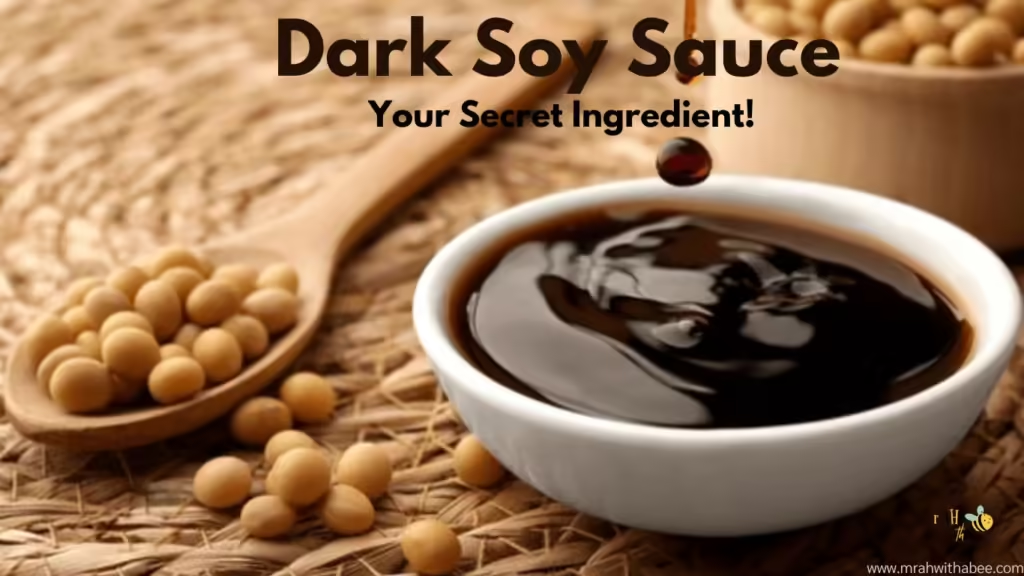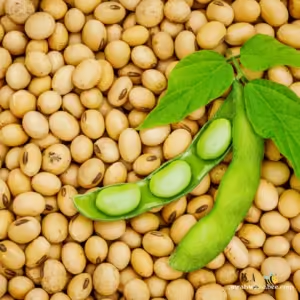Dark soy sauce is a famous ingredient in many Asian cuisines. Its deep color and rich complexity bring a unique taste to dishes, and it is a staple in many kitchens worldwide. Dark soy sauce enhances flavor and adds depth to your cooking, whether you are making stir fries, marinades, or braised dishes. In this blog post, we will explore the different types of dark soy sauces and their culinary uses.
What is Dark Soy Sauce?
Drak soy sauce is a sweeter version of regular soy sauce, recognized by its thicker texture and deeper color. It’s often aged longer, which contributes to its rich color and molasses-like flavor. Dark soy sauce stands out due to its full-flavored taste and ability to add color to dishes, while it shares similarities with both light soy sauce and tamari.
- Light Soy Sauce: Light soy sauce is saltier and thinner, commonly used for seasoning without affecting the dish’s color.
- Tamari: A Japanese soy sauce variant, often gluten-free, and has a richer taste.
Dark soy sauce is an important ingredient in various cuisines, celebrated for its unique taste, versatility, and ability to enhance the visual appeal of dishes. Whether you are preparing traditional Asian recipes or experimenting with new flavors, this soy sauce is a fantastic addition to your pantry.
Ingredients
Dark soy sauce typically includes:
- Soybeans: Soybeans are the primary ingredient essential for the rich umami flavor (earthy flavor) found in dark soy sauce. The beans undergo fermentation to develop the sauce’s depth and complexity. In addition to providing protein, soybeans also contain various beneficial nutrients, including vitamins and minerals.
- Wheat: The addition of wheat balances the flavors of the sauce and contributes to its sweetness and overall texture. This ingredient is essential for creating a smoother mouthfeel. Those with gluten sensitivity tamari is a gluten-free alternative.
- Salt: Salt enhances the flavor profile of the sauce while also preventing the growth of harmful bacteria during fermentation. It serves both as a seasoning and a preservative. While salt is necessary for flavor, it’s important to use dark soy sauce in moderation due to its high sodium content.
- Caramel or Molasses: These ingredients often deepen the color of the sauce and add sweetness. In particular, caramel contributes to the rich, dark color that distinguishes dark soy sauce from lighter varieties. The impact of flavor from caramel or molasses balances the savory elements, making dark soy sauce an essential ingredient in both sweet and savory dishes.
Some brands may include additives to enhance flavor, but traditional dark soy sauces rely on natural fermentation for depth.
Production Process
This sauce undergoes a fermentation process, which develops its complex flavors. The traditional process involves:
- Fermentation: Soybeans and wheat are combined and fermented over time. During fermentation, the enzymes break down the proteins in soybeans and wheat, changing them into amino acids and other elements that enhance umami flavors. The natural process of fermentation gives high-quality dark soy sauce its distinctive depth and character and allows the sauce to develop an umami profile.
- Quality Considerations: Look for brands that call for traditional fermentation methods when selecting dark soy sauce. As compared to those with artificial additives, these typically offer superior flavor and authenticity.
- Aging: Longer aging produces a deeper color and sweeter notes.
Some producers may add caramel coloring to darken the sauce, but traditional aging methods typically achieve this naturally.
Flavor Profile
Dark soy sauce is known for its concentrated and rich taste, with a touch of sweetness and a strong umami base. Compared to light soy sauce, it is less salty, making it ideal for adding depth without overpowering the dish. The sauce brings out the savory essence of ingredients when used in cooking and enhances both the flavor and color of dishes.
Taste Characteristics
- Richness: This richness comes from the longer fermentation process, which allows for the development of complex flavors that add a hearty quality to dishes. The depth of flavor in dark soy sauce is one of its defining features.
- Sweetness: Dark soy sauce has a subtle sweetness that balances its savory notes, distinguishing it from light soy sauce. This sweetness, often enhanced by the addition of caramel or molasses, contributes to its darker color and makes it suitable for a wide range of recipes.
- Umami Base: Dark soy sauce is a favorite among both chefs and home cooks alike. It provides a satisfying flavor that can elevate the taste of the meals, and its strong umami flavor makes it an excellent enhancer for savory dishes.
Versatility in Cooking
- Less Salty: The sauce adds depth to a dish without overpowering the other flavors, making it less salty than its lighter counterpart. This characteristic makes it an excellent choice for those who want to enhance the taste of their ingredients while keeping a balanced flavor profile.
- Enhancing Dishes: Dark soy sauce brings out the savory flavor of various ingredients, such as meats, vegetables, and grains when used in cooking. It works particularly well in stir fries, braises, and marinades, where it can infuse dishes with its rich flavor.
- Color and Presentation: Beyond flavor, dark soy sauce also enhances the visual appeal of dishes. Its deep color can transform the appearance of stir-fries, sauces, and glazes, adding an appetizing sheen that draws the eye.

Culinary Uses
It is a versatile ingredient in various dishes:
- Stir-Fries: Dark soy sauce adds a rich, deep flavor and enhances the color of vegetables and protein. It is a staple in stir-fry dishes and complements ingredients like bell peppers, broccoli, and chicken or beef, creating a beautiful and flavorful meal.
- Marinades: The sauce is commonly used in marinades for meats, tofu, and seafood. The ingredients are infused with its rich flavor while also helping to tenderize them. A simple marinade of this sauce, garlic, and ginger can transform your proteins.
- Sauces and Gravies: The sauce provides a salty base for dishes such as stir-fry noodles and can be mixed with ingredients like stock, vinegar, or sugar to create rich complexity. Dark soy sauce serves as a key ingredient in these flavorful combinations.
- Soups and Stews: It enhances the umami notes while contributing to a richer color, making it ideal for hearty dishes like beef stew or miso soup. Adding dark soy sauce to soups and stews deepens the overall flavor profile
- Glazes: When combined with honey or brown sugar, the sauce adds both sweetness and rich color to the finished dish as it caramelizes beautifully. It can be used to make shiny, flavorful glazes for roasted meats and vegetables.
- Dipping Sauces: Mixing it with sesame oil, vinegar, and chili creates a delicious dipping sauce that elevates your starters. This combination adds complexity and depth to dipping sauces for dumplings or spring rolls.
- Braised Dishes: The sauce is perfect for braising meats, imparting flavor, moisture, and a deep color. It works well in recipes for braised meat or chicken, where long cooking times allow the flavors to infuse beautifully.
What’s the best substitute for dark soy sauce?
- Regular Soy Sauce + Molasses or Brown Sugar: Add ½ teaspoon of molasses or brown sugar per tablespoon of regular soy sauce for added sweetness and color.
- Oyster Sauce: Thick and slightly sweet, oyster sauce can be a good alternative, especially in stir-fries and marinades.
- Hoisin Sauce: Similar in thickness and sweetness but stronger in flavor, so use sparingly.
Tips for Use
- Use sparingly, as it has a strong flavor.
- Pair with ginger, garlic, scallions, or sesame oil for classic Asian flavors.
- Mix with light soy sauce for balanced seasoning and color.
- For dipping sauce, combine with sesame oil, vinegar, and chili.
- Pair with sweet ingredients like honey or brown sugar to create a well-rounded taste.
Nutritional Information
This sauce provides certain nutrients, but it’s also high in sodium, so moderation is key. Here’s a typical nutritional breakdown per tablespoon:
- Calories: 10-15
- Sodium: ~900 mg
- Protein: ~1g
- Carbohydrates: ~2g
While this sauce isn’t a significant source of vitamins, its fermented nature may offer trace amounts of beneficial compounds, and moderate consumption can be part of a healthy diet.
Storage Tips
Proper storage helps maintain dark soy sauce’s quality:
- Store in a cool, dark place: Ideal for preserving flavor.
- Refrigerate after opening: Keeps it fresh for longer, though it’s not required.
- Shelf Life: The sauce lasts up to 1-2 years when stored properly. Discard if you notice a sour smell, mold, or separation.
Cultural Significance
FAQs
1. Can I substitute dark soy sauce with light soy sauce?
While they are different, light soy sauce can work in a pinch. However, it won’t give the same color or depth. Mixing a bit of molasses with light soy sauce can create a closer substitute.
2. Does dark soy sauce contain gluten?
Most of the sauces contain wheat, so they are not gluten-free. Look for gluten-free tamari if you need an alternative.
3. Is dark soy sauce vegan?
Yes, traditionally this sauce is vegan, made primarily from soybeans and wheat.
4. How much dark soy sauce should I use?
A little goes a long way! Start with a small amount, as its flavor can be intense, and adjust based on taste.
5. Can I substitute regular soy sauce for dark soy sauce?




